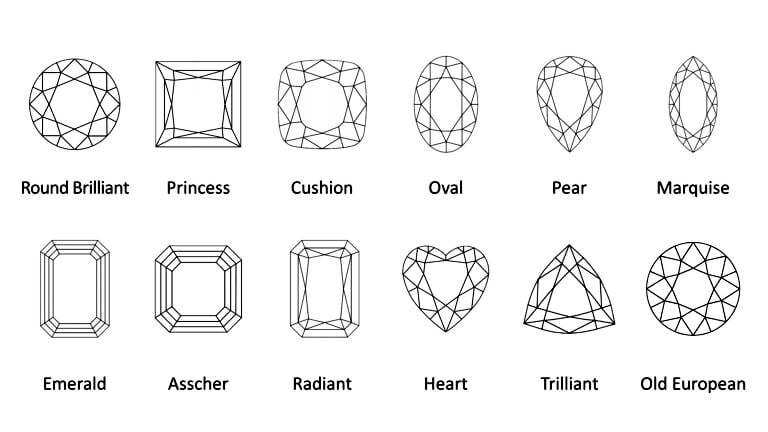Intermediate Diamond Shapes
PriceScope Advice
Choosing a diamond shape involves personal decisions. Beyond any shape’s basic geometry there are proportional choices involving length, width and overall aesthetic. What pleases one person most may not be optimal for the next person and the next. The advice below, while popular, must be considered for what it is: guidelines many people follow, reflecting broad consensus. Your individual taste and perception may differ, and that’s just fine.
Diamond Shapes: Round Brilliant

The round cut diamond continues to be the most popular shape for diamond jewelry and engagement rings. Universally flattering, with unrivaled sparkle, a beautifully cut round brilliant diamond displays the most possible brightness, fire, contrast and sparkle.
Length to Width Ratio: Rounds should be round, so we recommend a ratio of 1.00 – 1.03
PriceScope Advice:
Since most of the world’s diamonds have been cut as round brilliants we have compiled abundant information about this shape. The most important appears on our diamond cut page, which we highly recommend for any diamond shopper.
There are also several distinctly different subsets of Round Brilliant diamonds, each with their own specific visual properties. See three common round brilliant subsets here.
PriceScope Pointer: Take a cut quality shortcut. See our Descriptive Proportions Chart to know whether a round diamond shows more brightness, more fire, or a balance of both. Our longstanding Member Recommended Proportions are listed there too.
Diamond Shapes: Princess Cut

Princess cut diamonds use the brilliant cutting style on its pavilion to achieve the best scintillation of any square shape.
Length to Width Ratio: For a nicely square princess cut a ratio of 1.0 – 1.05 is optimal.
PriceScope Advice:
Most laboratories issue NO CUT GRADE for shapes other than round, but AGS offers full cut and performance grading for princess cuts.
A princess cut looks great in a variety of settings, but to ensure longevity, the corners of the diamond should be protected with prongs or a bezel setting.
Depending on how many chevrons a princess cut has on its pavilion, it can have between 24 and 40 facets. The more facets, the smaller the scintillation events generally appear. See our princess cut diamonds page to learn more.
Ideal Fancy Shapes! Every Whiteflash A CUT ABOVE® princess has an Ideal cut grade from the American Gem Society (AGS). The JamesAllen.com True Hearts™ collection includes both princess and cushion cuts graded by AGS.
Diamond Shapes: Cushion Cut

The outline of a cushion cut diamond resembles a pillow or cushion; a square shape with soft, rounded corners. Unlike other standardized shapes, there are many variations of cushion cuts with different visual character.
Length to Width Ratio: If you’re seeking a square cushion, we recommend a ratio between 1.0 – 1.09. If you prefer a subtle rectangle, that can move up to 1.15-1.25.
PriceScope Advice:
The 70-70 rule of cushion cuts advises staying with cushions which have a table % under 70% as well as a total depth % under 70%. This helps to ensure you’re not paying for a diamond with extra weight in the belly, and ensures a small enough table to foster dispersion.
Personal preference comes into play when considering this shape, because of the variety of appearances available. We recommend they be assessed on a case by case basis. While we give some broad outlines here, experts within the PriceScope community agree that there are no hard and fast rules when it comes to cushion cut diamonds.
Diamond Shapes: Emerald Cut

Hearkening back to a cutting style for gemstones of the same name, the emerald cut diamond features a large table, and long straight lines giving a clean, elegant appearance.
Length to Width Ratio: For the classic emerald cut aesthetic we recommend 1.50 – 1.75
PriceScope Advice:
The step cutting style and large table on the emerald leave few places for inclusions to hide. Color saturation is also more noticeable in this shape so those seeking clean, colorless appearing diamonds will want to gravitate towards H-VS2 and higher.
Fortunately, emerald cuts are great at maximizing carat weight, giving a bigger face-up size than brilliants of equivalent carat weight.
Diamond Shapes: Asscher Cut

Nicknamed the emerald cut’s sparkling sister, the Asscher cut diamond was developed by the Asscher Brothers in Holland in 1902. Modern Asscher cuts use an emerald cut basis but use cut-corners to create an octagonal outline along with a smaller table and layered facets designed to create a hypnotic pattern.
Length to Width Ratio: For the square Asscher shape, 1.0 – 1.05 is optimal
PriceScope Advice:
The Asscher cut masks clarity better than the emerald cut but does not conceal color efficiently so for those seeking colorless appearance we still encourage H color and higher.
The primary appear of the Asscher is aesthetic. It does not appear as large for the weight as an emerald cut but offers more fire and sparkle than similar emerald cuts due to the smaller table and higher crown.
Expert Assistance: Our short list of vetted vendors, like Blue Nile have experienced gemologists on staff to help you find the perfect fancy fit. Email, text or call one of them with questions.
Diamond Shapes: Oval Cut

The oval cut diamond has brilliant facets, providing sparkle and brightness in an elongated shape that sets it apart from a round brilliant.
Length to Width Ratio: A ratio of 1.30 to 1.50 works beautifully for an oval shape, but this is subject to personal taste.
PriceScope Advice
The oval cut sometimes display a bow-tie effect. Viewing a diamond spin-video or images under a variety of lights will help you to identify this. A large bow tie is essentially a permanent shadow across the diamond. Proper cutting can minimize the bow-tie effect.
Ovals cost less than equivalent round brilliants while remaining bright and lively.
Diamond Shapes: Pear Shape

The pear shaped diamond is a timeless cut with the brilliant style of faceting and a unique shape aesthetic. Though traditionally worn with the tip pointing at the wearer’s heart, the pear cut may be set and worn in a variety of ways.
Length to Width Ratio: It’s all about personal preference, but the traditional ratio runs from 1.45 – 1.75.
PriceScope Advice
The beauty of a pear cut hinges on symmetry. This symmetry ensures an even sparkle across the diamond. You can review a variety of ratios to establish your preference. While the symmetry is essential a slim, long pear cut can be just as beautiful as a shorter, wider shape.
Like the oval, pear cuts sometimes display the bow-tie effect. Viewing a diamond spin-video or images under a variety of lights will help you to identify this. A large bow tie is essentially a permanent shadow across the diamond. Proper cutting can minimize the bow-tie effect.
Diamond Shapes: Marquise Cut

Sometimes referred to as a navette cut, the marquise cut diamond was originally fashioned for King Louis XIV. It reached incredible popularity in the late 1900s and can frequently be found second-hand, in jewelry stores and estate sales.
The graceful shape can be worn vertically on the finger, seeming to elongate the hand, or angled for a more contemporary look.
Length to Width Ratio: We recommend a ratio of 1.85 to 2.1
PriceScope Advice:
Like the oval and pear, marquise cuts sometimes display the bow-tie effect. Viewing a diamond spin-video or images under a variety of lights will help you to identify this. A large bow tie is essentially a permanent shadow across the diamond. Proper cutting can minimize the bow-tie effect.
Also, like the pear-shape, the marquise depends on symmetry to ensure even sparkle across the diamond.
When being set, a pair of prongs should support the pointed ends to prevent chipping. Thanks to its elongated shape the marquise can appear larger than other diamonds of the same carat weight.
Diamond Shapes: Radiant Cut

The radiant cut diamond is a mixed cut which was developed by Henry Grossbard family in 1977. It offers dazzling fire and brilliance and the cut corners create a shape aesthetic that pairs well with either round or square shapes.
Length to Width Ratio: For square radiants we recommend a ratio of 1.0 – 1.05. For rectangular shapes you can consider ratios up to 2.0
PriceScope Advice:
The facet patterning of a radiant cut is adept at concealing inclusions allowing you to maximize your money by buying a lower clarity grade if you wish. The cut corners of radiant cuts make them a great choice for wearers with an active lifestyle.
Diamond Shapes: Heart Shape

A complex cut, the beauty of a heart shaped diamond is more in its balance and proportions than optical qualities such as brightness or fire.
Length to Width Ratio: A ratio between 1.0 and 1.1 is most desirable for the heart shape. Going above 1.1 will make the heart appear stretched.
PriceScope Advice:
A well-cut Heart Shaped Diamond should be symmetrical, so it appears balanced and full. A defined cleft and distinct, pointed lobe will give a cleaner silhouette.
The heart shape is most appealing and effective in higher carat weights.
Diamond Shapes: Trillion Cut

The trillion cut diamond, also known as the triangular brilliant, trillions and trilliant, is a bright and lively cut. These diamonds work well as side stones to accentuate a variety of diamond shapes but can also look spectacular as a solitaire.
Length to Width Ratio: As with its cousin, the heart shape, a ratio between 1.0 and 1.1 is most desirable.
PriceScope Advice:
A trillion shaped diamond is often cut shallow. The perfect proportions will yield a good face-up size but a trillion that has been cut too shallow will lack brilliance.
The corners should be protected by the setting to avoid chipping.
Diamond Shapes: Baguette

The baguette diamond is a cousin to the emerald cut with fewer facets. In fact, the traditional 14 facet baguette diamond is one of the most clean and simplest shapes. Like any rings featuring step cuts, baguette diamond rings will have different visual character than rings featuring brilliant cuts. The baguette diamond is a popular choices for accenting a featured stone, typically set horizontally, one baguette diamond per side.
Length to Width Ratio: Baguette diamonds are typically long and thin. The common ratio is around 5.1. .
PriceScope Advice:
The step cutting style and large table on baguette diamonds leave few places for inclusions to hide. Color saturation is also more noticeable in a baguette diamond ring so those seeking clean, colorless appearing diamonds will want H color or higher.
Fortunately, well cut baguette diamonds are great at maximizing carat weight.
























